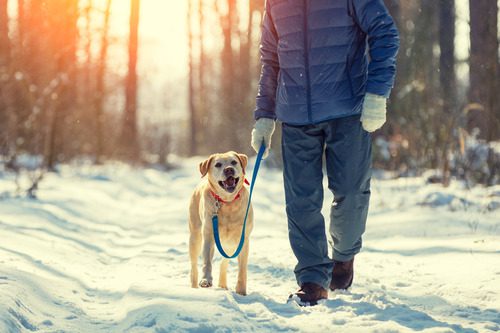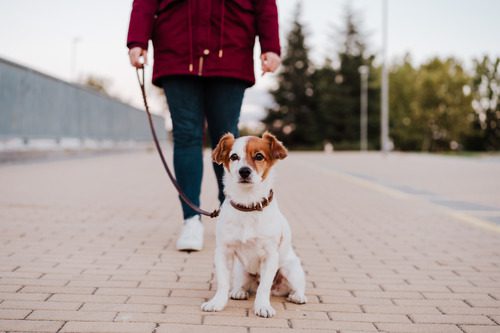7 Signs of Hypothermia in Dogs and How to Protect Your Pet
As winter approaches, dog owners need to stay aware of how cold temperatures affect their pets. While a dog’s fur provides some insulation, it doesn’t always offer full protection in harsh conditions. Prolonged exposure to cold weather can lead to hypothermia, a potentially serious condition that every pet owner should recognize and try to prevent to the best of their ability. Let’s take a look at the signs of hypothermia in dogs and the steps you can take to keep your pet safe during colder months.

What Is Hypothermia in Dogs?
Hypothermia occurs when a dog’s body temperature drops below normal levels, typically falling under 99°F. The condition is caused by prolonged exposure to cold environments, especially when a dog is wet or unable to find shelter. Small breeds, puppies, senior dogs, and dogs with thin coats are particularly vulnerable to hypothermia. If left untreated, hypothermia can lead to shock, organ failure, or even death.
What Causes Hypothermia in Dogs?
Hypothermia can result from several factors, including cold weather, immersion in icy water, or prolonged exposure to snow. Wet fur accelerates heat loss, making dogs more susceptible to hypothermia in rainy or snowy conditions. Dogs left outside for extended periods, especially without proper shelter, are at a high risk. Certain medical conditions, such as hypothyroidism, can also make dogs more prone to hypothermia.
Shivering
Shivering is your dog’s way of generating heat and maintaining their body temperature. However, persistent or uncontrollable shivering is a warning sign that your dog is struggling to stay warm. If you notice shivering that lasts longer than a few minutes, it may be time to bring your dog indoors and monitor their condition closely.
Lethargy or Fatigue
A dog experiencing hypothermia will often become lethargic or fatigued. Cold temperatures drain your pet’s energy as their body works harder to maintain warmth. You might notice your dog moving more slowly or seeming uninterested in play or exercise. In severe cases, they may struggle to stand or walk properly. This loss of energy is a serious sign that your dog’s body temperature has dropped too low.
Pale or Gray Gums
Checking your dog’s gums is an effective way to assess their health in cold weather. Hypothermia reduces blood flow, which may cause a dog’s gums to appear pale, gray, or even blue. This is a signal that your pet’s circulation is compromised, and immediate action should be taken. If you observe these changes in gum color, contact your veterinarian at The Village Vets – Plymouth Meeting right away for guidance.
What Does Healthy Gum Color Look Like?
Healthy gums in dogs should be pink and moist. A sudden change to pale or discolored gums, especially accompanied by other signs of hypothermia, warrants urgent attention. Keep an eye on your dog’s gum color when they’ve been outside in cold weather, especially if you suspect they may be getting too cold.
Weak Pulse
A dog suffering from hypothermia may have a weak or slow pulse due to decreased blood circulation. The colder your dog gets, the more their body struggles to pump blood efficiently. This can lead to a faint or difficult-to-detect pulse. If you’re unsure how to check your dog’s pulse, you can place your fingers gently on their chest, just behind the front leg, to feel for their heartbeat.
Stiff Muscles or Difficulty Moving
As hypothermia progresses, a dog’s muscles may stiffen, making movement difficult or painful. You might notice that your dog seems unusually stiff when walking or has trouble moving their legs. In more severe cases, they may even collapse due to muscle weakness. If your dog is struggling to walk or their movements seem strained, hypothermia could be the cause.
Breathing Problems
When a dog’s body temperature drops too low, their respiratory system slows down. Your dog may take longer breaths or breathe less frequently than normal. In advanced stages of hypothermia, breathing may become irregular or labored, signaling a medical emergency.
Loss of Consciousness
Loss of consciousness occurs when the body can no longer regulate its core temperature, leading to severe internal coldness. If your dog becomes unresponsive or unconscious, seek veterinary help immediately. At this point, the situation is life-threatening, and prompt action could save your dog’s life.
How to Protect Your Dog from Hypothermia
Preventing hypothermia in dogs starts with being aware of their needs during cold weather. Here are some practical ways to protect your pet from the dangers of hypothermia:
- Limit Outdoor Time: During cold months, reduce the amount of time your dog spends outside. If the weather is especially harsh, keep walks brief and provide indoor enrichment to keep your dog entertained.
- Provide Warm Shelter: Ensure your dog has a warm, dry shelter if they need to be outside. Heated dog houses or well-insulated shelters with blankets can make a significant difference in keeping your pet warm.
- Dress for the Weather: Consider using dog sweaters or coats for dogs with short fur or those more susceptible to the cold. A well-fitting dog coat can offer an extra layer of protection against the chill.
- Check for Wet Fur: Wet fur can quickly lead to hypothermia. After outdoor walks in the rain or snow, thoroughly dry your dog’s coat and paws to help retain body heat.
- Monitor Body Temperature: Keep an eye on your dog’s behavior and body temperature when they’ve been outside. If they seem cold or uncomfortable, bring them indoors immediately and warm them up gradually.
Keeping your dog warm and safe during cold weather is about more than just comfort—it’s about helping them stay healthy all winter long. When you can recognize the signs of hypothermia early, you can act quickly to protect your pet from the dangers of extreme cold. Pay attention to their behavior, limit exposure to freezing temperatures, and always provide a cozy, dry place for them to retreat. If you’re ever unsure whether your dog is showing symptoms of hypothermia, call The Village Vets- Plymouth Meeting at (484) 820-1700, or schedule an appointment online.
Recent Posts
About The Village Vets
The Village Vets of Plymouth Meeting offers excellent service to clients in a comfortable, friendly atmosphere. To learn more about us and how we can better serve you and your pet here in Plymouth Meeting, PA, click the button below.
Share This Post
Recent Posts
About The Village Vets
The Village Vets is a network of three animal hospitals based in Atlanta, GA and the surrounding area. We offer honest, excellent service to our clients in a comfortable, friendly atmosphere. To learn more about our locations and how we can better serve you and your pet, click the button below.




